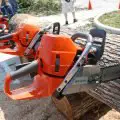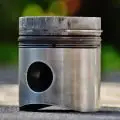Chainsaws are among the most efficient power tools around. Very few other tools are capable of moving a few hundred tonnes of wood with minimal effort. From felling trees to chopping firewood and carving, a high-quality all-round chainsaw is an arborist’s best friend.
Anyone who is familiar with using chainsaws will know that they require regular maintenance in order to keep them in their optimum condition. If you accidentally skip servicing when it is required, any chainsaw can start to develop problems that require troubleshooting.
From experiencing difficulties with getting the engine to start to a chainsaw engine stalling and not working properly, we have put together a guide on how to troubleshoot each issue. This article will focus on the most common problems and how to fix them.
Table of Contents

Chainsaw Troubleshooting Guide
Chainsaws, regardless of their type, will work better and last longer if they’re properly maintained. Sometimes during your occasional chainsaw inspection, you might spot an issue like a dull chain. However, not all chain problems will be visible, especially if you’re new to chainsaws and are unsure what to look for.
There can be many possibilities as to why you’re facing a problem with your chainsaw. This is why we’ll take a look at the most common problems and more importantly, some solutions to help troubleshoot your chainsaw and get it working again.
You may be surprised, but some of the most common chainsaw problems are really not too difficult to fix at all. It doesn’t matter what skill level you are at, even if you’re a beginner, you will be able to do most of these repairs and troubleshooting yourself. Without the need for spending money on a professional!
In addition to these chainsaw troubleshooting tips, I will always recommend checking out the user’s manual provided by your chainsaw manufacturer, as this will provide detailed instructions on how to operate your chainsaw and potentially troubleshooting advice for your specific chainsaw.
Anyway, here are the most common problems with chainsaws:
- Chainsaw won’t start
- Chainsaw starts but then stalls
- Chainsaw is running rough
- Chainsaw chain is not turning
- Chainsaw chain won’t stop turning
- Chainsaw won’t cut
- Chainsaw lacks power
- Chainsaw engine smokes
- Chainsaw chain is clattering
Now, let’s take a look at each problem and how to troubleshoot them!
Chainsaw Won’t Start
If your chainsaw won’t start, there are 3 checks you can conduct:
1. Check the Spark Plug
First off, you should check to see if the spark plug is defective. You can remove it and figure out whether the porcelain on it has cracked, the electrode has become damaged, or there is a heavy carbon build-up. If any of these are the case, then you should replace the spark plug gap immediately.
2. Check the Carburetor
The next check should be checking if the carburetor has clogged. If you leave the fuel line for an extended period of time in the chainsaw it can cause a carburetor to become clogged which may prevent the engine from starting.
You can easily clean the carburetor with a can of carburetor cleaner. If cleaning doesn’t work you can replace the component.
3. Check the Ignition Coil
Another reason why the engine of your chainsaw may fail to start is because of a faulty ignition coil. The ignition coil transmits voltage to the spark plug when the engine is on. If you’ve checked the spark plug first and the chainsaw still isn’t working properly, then you can change the ignition coil. It’s possible to also use an ignition coil tester for this chainsaw troubleshooting procedure.
To learn more problems and solutions for why your chainsaw won’t start, visit our guide!
Chainsaw Starts But Then Stalls
If your gas chainsaw is starting up as normal but then stalling not long afterward, you’re likely to have an issue with your spark arrestor or air filter.
In order to solve this problem, you should first check the spark arrestor to see if it is preventing the engine from emitting sparks. Soot can easily clog the spark arrestor after extended periods of using the gas chainsaw. And as a result, the gas-powered chainsaw starts but then stalls, or runs rough. If necessary, remove the spark arrestor and clean it with a wire brush. If this doesn’t help, replace the component.
On the other hand, it could be that the air filter is dirty or clogged. This will cause the engine to have too much fuel and less air, resulting in an imbalanced fuel mix ratio, hence, the engine will stall. Inspect the air filter to see if it’s clogged and then clean it with soapy water. Otherwise, you will need to replace the air filter with a new one.
Chainsaw is Running Rough
If your chainsaw is running rough, the first thing to check is the foam filter. In most cases, it’ll be dirty or clogged. The solution to this problem is easy, simply replace the foam filter and you’re good to go. On the other hand, it could be a clogged fuel filter.
Leaving old fuel to sit in the chainsaw fuel line for extended periods of not using it, can cause a fuel filter to become clogged. Some ingredients in the fuel will evaporate over time and leave behind a thicker and stickier substance. This substance can clog up the fuel filter with ease, and as a result, cause the chainsaw engine to run rough.
When you replace the fuel filter, you should also make, sure to also drain the old fuel and replace it with a fresh batch.
Chainsaw Chain is Not Turning
If your chainsaw chain is not turning, you should first take a look at the clutch. The clutch pads activate the clutch drum in order to rotate the chain. If the clutch pads are worn out, the motor will still run but the clutch drum will not be engaged and therefore the chain will not turn.
If you notice that the stop lever is engaged, this will also cause the chain to not rotate. So, first, disengage the stop lever, and then if you have worn-out clutch pads, replace the whole clutch assembly.
Another reason for the chain not turning could be the clutch band drum brake which is designed to activate the clutch drum to rotate the chain. In a similar manner, if the clutch band is worn out, the motor will function but the clutch band will not activate the clutch drum. Therefore, you will need to replace the clutch band if it’s worn out to get the chain to turn.
Chainsaw Chain Won’t Stop Turning
If your chainsaw chain won’t stop turning, you may need to either adjust the carburetor or replace the clutch.
Adjusting the Carburetor
Upon finishing your task with the chainsaw and releasing the throttle, you naturally expect the chainsaw to stop. But if it doesn’t, then you should first take a look at the carburetor. A poor idle setting adjustment in the carburetor could be the problem, and a simple solution would be to adjust the carburetor adjustment.
What happens if the carburetor is adjusted wrong, is that fuel will still flow in the combustion chamber upon releasing the throttle. Hence, the chainsaw won’t stop turning.
To solve this problem you will need to fix the idle screw on the carburetor which is located near the air filter. Turn the screw clockwise slightly using a screwdriver to prevent fuel flow until the chainsaw chain stops turning. You will need to ensure the chainsaw is running when you’re doing this task to ensure you don’t adjust the carburetor too much.
Replacing the Clutch
Another possibility as to why the chainsaw chain doesn’t stop turning could be due to broken springs or non-sticking clutch pads. If the springs are broken, the clutch pads won’t pull in and the chain will continue to turn. If the clutch drum is engaged by sticking clutch pads then the chain will also continue to rotate.
The solution is to fix the clutch assembly so that the chain turns properly again. You may need to replace the whole clutch.
Chainsaw Won’t Cut
If you’re having difficulty with your chainsaw not cutting, it’s likely you have an issue with your chainsaw chain or guide bar. You will need to do either of the following:
1. Replace or Sharpen the Chain
If your chainsaw is not cutting, it’s probably because the chain itself is dull and needs to be replaced or sharpened. When a chain is dull, it will cause unnecessary wear and tears to the clutch, engine, and many other components because the chain is working harder to compromise the dullness.
Another symptom of a dull chain is the Chainsaw Won’t Cut Straight. One best way to sharpen a chainsaw is by mounting a file into a sharpening guide, if you’re filing by hand that is. Otherwise, you can take the chainsaw to the nearest shop to be sharpened.
2. Adjust the Chain
Another reason why your chainsaw won’t cut might be that your chain is not adjusted properly. If the adjustment screw is loose on the chainsaw, the chain may not be gripping the wood as it should cut it.
On the other hand, if the chain is too tight, it will not rotate at the proper speed, and as a result, it will not cut as expected. Therefore, you will need to loosen the adjustment screw.
You could also have the Chainsaw Blade Direction the wrong way, meaning that the chainsaw’s chain’s teeth are in the wrong direction and aren’t able to cut through your wood.
3. Replace the Guide Bar
Finally, if your chainsaw won’t cut, it could be due to a worn-out chain bar. The chain, in normal cases, should slide easily around the chain bar. If it isn’t able to, this is a great indication that you may need to replace the guide bar.
This could also be due to insufficient oil. When you’re using your chainsaw, always be sure that the oil reservoir is filled with sufficient bar oil. As this is essential for keeping the bar well lubricated so that it doesn’t wear out so quickly.
Chainsaw Lacks Power
If your chainsaw is lacking power, there are various components you will need to check. These include inspecting the piston, muffler, cylinder, and spark plug for any signs of wear and tear. A plugged spark arrestor, muffler, or cylinder exhaust port will prevent the exhaust gases from being able to leave the engine and as a result, you will notice a reduction in engine power.
These crucial components of a chainsaw can become clogged with carbon, so, you should first attempt to clean them. If cleaning doesn’t make any significant improvement, it’s time to replace them to ensure efficient functionality.
The piston and cylinder in gas-powered chainsaws work together to facilitate combustion for powering the chainsaw. If the ring in the piston breaks off and falls, it will reduce the ability to create the necessary compression. In this scenario, the chainsaw will no longer be running at its best and will result in a lack of power. You will need to replace the ring or the piston and cylinder to repair this issue.
Chainsaw Engine Smokes
Having a Chainsaw Smoking When Cutting can be very bad news and ultimately delay any project you’re working on. In most cases, it’s likely that something is wrong with the type of fuel you’re using, you have a wrong ratio, or your chain bar is too hot.
To pinpoint this chainsaw problem, check whether the smoke is coming from the engine or the chainsaw. You can:
1. Smoke Coming From the Chainsaw Engine: Check the Fuel
If the smoke is coming from the engine, this is an immediate issue since it can lead to significantly worse damage to the engine. This is typically due to improperly mixed or contaminated fuel. Fuel used in chainsaws is a mixture of oil and gasoline. The ratio of this mixture differs with different chainsaw brands and models but in most cases it will usually be 40:1 or 50:1.
You should check your chainsaw manual to ensure that you are using the proper ratio. Otherwise, it could be contaminated fuel with water, dirt, or wood particles, which is making your fuel go bad. In both situations, you should empty the fuel from the chainsaw before replacing it with clean and in the right ratio fuel.
2. Smoke Coming From the Chainsaw Blade: Check the Oil Reservoir and Chain Tension
If the smoke is coming from the chainsaw blade, then this is an indication that the chainsaw bar is not properly lubricated or there is a problem with the chainsaw chain tension. You must make sure that there’s enough oil in the guide bar oil reservoir. If not, then fill it up. If the problem comes from the chainsaw chain tension, make sure that the chain is not too tight or too loose, as previously described.
Chainsaw Chain is Clattering
If your chainsaw chain is clattering, you can follow these 3 steps:
1. Check the Bar and Chain
The chainsaw chain clattering noise could be because of several factors like a twisted chain bar, a dull chain, and tension adjustment. The great news is that you can easily replace a twisted chain bar as long as you know the measurements. Visit our How to Measure Chainsaw Bar guide for more information!
2. Adjust the Tension of the Chain
Chainsaw chains naturally stretch out with time and use due to the constant friction and heat they undergo. Adjusting the chain regularly can help prevent this clattering. Keep an eye out for the chain sagging below the bar as you will know it’s loose and needs tightening.
However, it’s important to not tighten the chain too much. You will know if the chain is too tight as you won’t be able to pull it slightly away from the guide bar.
3. Check the Chainsaw Oil Level
The gasoline oil mixture you put into the engine will only lubricate the engine and not the chain. You need specific bar oil for the chainsaw bar. Some chainsaws have manual oilers while others have automatic oilers and you won’t need to do anything.
Make sure that the bar oil reservoir tank is full and use the best chainsaw oil for the bar like SAE 30 oil. You can refer to the user’s manual for this step to get specific oiling advice for your chainsaw.
Common Issues Can Be Preventable
Most of the common chainsaw issues mentioned in this article are easily resolvable and preventable. If you buy a popular all-round chainsaw with a great warranty and good reviews, you can rest assured that you’ll hardly come across any problems.
However, taking good care of your chainsaw by conducting proper maintenance and following the manual requirements will only help you to avoid the worst issues. You may have the occasional small wear and tear problem but you can prevent many of them.
Of course, the majority of these troubleshooting problems are only faced by gas-powered chainsaws. A corded electric chainsaw and a battery chainsaw generally require less maintenance and generally face fewer troubleshooting problems.
Either way, being aware of these most common chainsaw problems will help prepare you for the inevitable and make it easy and quick for you to repair any issues or replace any faulty or worn-out parts. While also saving you the cost and time of visiting a professional.
FAQs (Frequently Asked Questions)
Why does my chainsaw stall when I give it gas?
You’re likely to have an issue with your spark arrestor or air filter. First, check the spark arrestor to see if it is clogged to see if it is preventing the engine from emitting sparks. Otherwise, it could be that the air filter is dirty or clogged. Inspect the air filter to see if it’s clogged and then clean it with soapy water or replace the air filter with a new one.
Why does my chainsaw start and then stop?
Your chainsw is starting and then stopping because either, or both, of its filters have become clogged. A chainsaw has two filters to regulate air circulation and one to keep debris out of the fuel. Both need regular servicing otherwise they will become clogged. A dirty air filter, which filters air coming through the intake port, or spark arrestor, which filters the exhaust, will impede air circulation and cause the engine to stop.
How do you fix a chainsaw that won’t stay running?
To fix your chainsaw you will need to check both the spark arrestor and air filter to see if either are clogged. They’re the most likely causes of a chainsaw stalling. Clean both, and if this doesn’t work, you should replace them immediately.






A 62 CC knock off chain saw ….new….
25:1 fuel is doing very high fuel consumption. 10min ea on first 2tanks. Starts fine and good power. Cap tight and no leaks ???